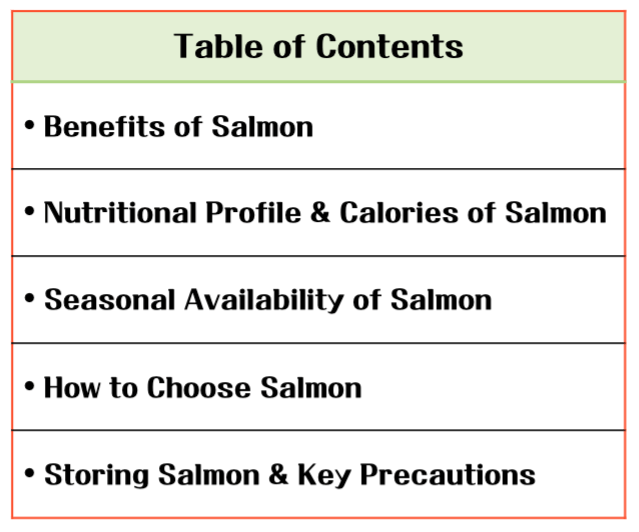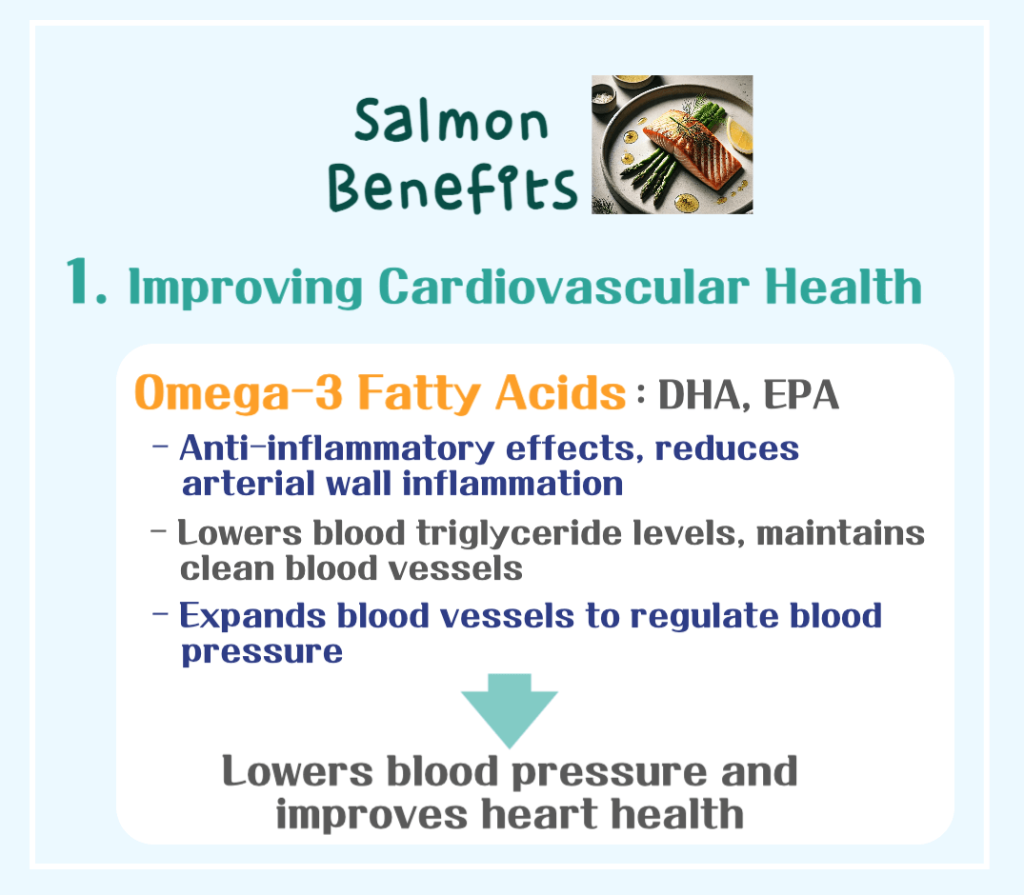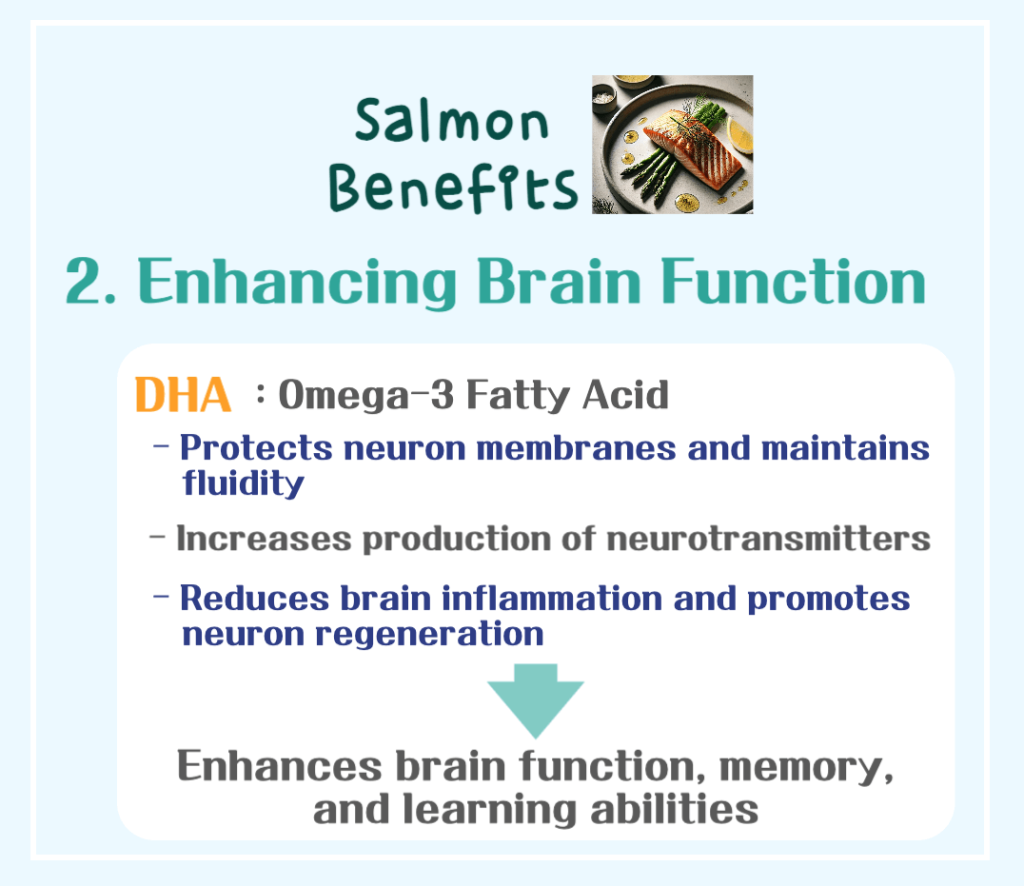The Treasure Trove of Omega-3! Salmon Benefits & Calories: A Superfood for Joint Health
Through ‘The Treasure Trove of Omega-3! Salmon Benefits & Calories: A Superfood for Joint Health’ post, let’s explore the benefits of salmon, its nutritional components, calorie content, seasonal availability, tips on how to choose quality salmon, and methods for proper storage.
A One-Line Summary of Salmon:
“A treasure trove of Omega-3! A perfect source of protein.”
Salmon’s unique life cycle, where it returns to spawn each year, has made it a powerful symbol of survival and resilience. Indigenous peoples of Northern Europe and Alaska relied on salmon as a key food source, preserving the returning fish each year to sustain themselves. Salmon’s exceptional nutrition, especially its high omega-3 fatty acid content, has been scientifically shown to support cardiovascular health, brain function, and joint health. This beloved superfood is valued for its taste, nutrition, and numerous health benefits.
Let’s explore the benefits, nutrition, seasonality, and selection tips for salmon with visuals and easy-to-follow tables.

Now, let’s dive in!
- Benefits of Salmon
1. Improves Cardiovascular Health

* The rich omega-3 fatty acids in salmon inhibit inflammatory responses, lower triglyceride levels, and prevent blood clots, thus reducing the risk of heart diseases such as myocardial infarction and stroke.
※ Omega-3 Fatty Acids
– Anti-inflammatory properties:Reduces inflammation in arteries by inhibiting cytokines and similar inflammatory agents, promoting arterial health and smooth blood flow.
– Reduces triglycerides:Helps keep blood vessels clean by lowering triglyceride levels.
– Blood pressure regulation:Improves vascular function and enhances nitric oxide (NO) production, promoting vasodilation and blood pressure control.
– Prevents blood clots:Inhibits platelet aggregation to prevent clots.
2. Enhances Brain Function

* The high DHA content in salmon improves brain function, memory, and learning capacity while helping prevent cognitive decline due to aging. Salmon also aids in preventing neurodegenerative diseases like Alzheimer’s, promoting brain cell protection and regeneration.
※ DHA (Docosahexaenoic Acid):An essential omega-3 fatty acid
– Maintains cell membrane fluidity:Integral to neuron membranes, maintaining flexibility for efficient neurotransmission, improving memory and cognitive function.
– Increases neurotransmitter production:Boosts serotonin and dopamine production.
⦁Serotonin:Helps regulate mood and alleviate anxiety.
⦁Dopamine:Plays a key role in motivation and learning.
– Promotes neuron regeneration:Supports the formation of new neurons, enhancing memory and learning ability.
3. Supports Joint Health

* Salmon’s omega-3 fatty acids reduce symptoms of inflammatory conditions like arthritis, alleviating joint pain and improving movement and flexibility, making it beneficial for those with chronic inflammatory diseases like rheumatoid arthritis.
※ Omega-3 Fatty Acids (DHA, EPA)
– Anti-inflammatory effect:Strong anti-inflammatory properties inhibit inflammatory responses within the body, relieving joint inflammation.
– Regulates immune responses:Modulates immune reactions to reduce autoimmune inflammatory responses, protecting joints.
– Protects cartilage and lubricates joints:Protects cartilage cells and enhances joint fluid lubrication.
– Alleviates joint pain:Relieves pain in joints with analgesic effects.
4. Protein Supply & Muscle Recovery

* Salmon’s high-quality protein promotes muscle growth and aids in post-exercise muscle recovery, making it ideal for physically active individuals or those seeking to increase muscle mass.
※ High-Quality Protein:Contains all essential amino acids.
– Supports tissue regeneration:Crucial for rebuilding muscles, skin, cells, and organs.
– Promotes muscle synthesis and recovery:Accelerates new muscle fiber formation and the rebuilding of damaged muscles.
– Prevents muscle loss and sarcopenia with steady protein supply.
5. Enhances Skin Health

* Salmon’s omega-3 fatty acids maintain skin moisture and stimulate collagen production, enhancing skin elasticity. Astaxanthin, a powerful antioxidant, neutralizes free radicals, protecting skin from damage due to UV exposure and pollutants.
※ Omega-3 Fatty Acids (DHA, EPA)
– Moisturizes skin:Maintains cell membrane fluidity, preventing water loss.
– Stimulates collagen synthesis:Inhibits collagen breakdown and supports new collagen formation, improving skin elasticity.
※ Astaxanthin:Potent antioxidant
– Neutralizes free radicals:Reduces oxidative stress on skin cells, preventing damage from UV and pollutants.
6. Additional Benefits

* Other Benefits: Weight Management, Cognitive Function Enhancement, Eye Health, Anti-Cancer, Liver Health, Blood Sugar Control, Immune Boost
※ Eye Health:Omega-3s protect retinal cells, reducing eye inflammation and playing a crucial role in vision.
※ Weight Management:Salmon’s high protein content slows digestion, promoting satiety and helping prevent overeating. Omega-3s also promote fat metabolism, reducing fat storage.
※ Cognitive Enhancement:Omega-3s in salmon balance neurotransmitters in the brain, stabilizing mood.
※ Blood Sugar Control:Omega-3s enhance insulin sensitivity, aiding blood sugar control.
※ Liver Health:Omega-3s reduce fat buildup in the liver, preventing non-alcoholic fatty liver disease (NAFLD).
※ Cancer Prevention:Omega-3s suppress cancer cell growth, lowering cancer risk. Astaxanthin’s antioxidant effects also prevent colon, breast, and prostate cancers.
- Nutritional Profile & Calories of Salmon

* Caloric Content:206 kcal per 100g.
* Rich Nutrient Source:Salmon is a high-protein food abundant in omega-3 fatty acids (EPA, DHA), selenium, potassium, and magnesium, all beneficial for overall health and bodily functions.
- Seasonal Availability of Salmon

* Best Season:August to December.
* Salmon, a migratory species, returns to rivers to spawn, accumulating high levels of fats and nutrients, resulting in optimal taste and texture.
* Seasonal Variations by Species
– Pacific Salmon:August to November (fall), returns to rivers for spawning during this period, containing high levels of omega-3 fatty acids.
– Atlantic Salmon:September to December (fall to early winter), returns to rivers for spawning, available as both wild-caught and farmed.
※ Characteristics of In-Season Salmon
– Rich in fat with a soft, moist texture.
– Firm flesh with an optimal balance of fat, providing a soft texture and deep flavor.
– Contains well-developed roe and milt (reproductive organs of salmon).
※ Characteristics of Farmed Salmon:
– Available year-round, not restricted by season.
– Lacks natural spawning cycles, so there is less seasonal variation in taste.
– However, even farmed salmon tends to have a relatively higher fat content in the fall.
- How to Choose Salmon

※ Prepped Salmon:
* Color:Should have a bright pink or orange hue with a slight natural sheen.
* Firmness:Feels firm and resilient when pressed.
* Fat Lines:White fat lines should be evenly distributed throughout the flesh.
* Wild Salmon:Typically has a softer, lighter color, with thinner fat lines and higher omega-3 fatty acid content.
* Farmed Salmon:Generally displays a darker color with thicker fat lines.
- Storing Salmon & Key Precautions
1. Storage Tips
* Refrigeration:Store at 0-4°C, consume within two days. Wrap in paper towel and seal in plastic wrap or foil.
* Freezing:Store at -18°C, consume within three months. Separate into portions, wrap in foil, and vacuum seal for long-term preservation.
2. Precautions
* When Storing Salmon:Maintain a consistent temperature, store in the coldest part of the refrigerator, and avoid refreezing after refrigeration.
* Thawing Method:Transfer frozen salmon to the refrigerator and allow it to thaw for 12–24 hours.
* Quick Thawing:If short on time, place the sealed salmon in cold water, changing the water frequently to speed up thawing. Avoid thawing at room temperature.
* Avoid Using the Microwavefor thawing.
In ‘The Treasure Trove of Omega-3! Salmon Benefits & Calories: A Superfood for Joint Health’ post, we’ve explored the numerous benefits of salmon, including its nutritional components, calorie content, seasonal availability, tips for selecting the best salmon, and proper storage methods. I hope this has provided you with a deeper understanding of salmon and its health benefits.
Here are some related posts you may enjoy.
For information on the prices and fluctuations of food ingredients, you may find the following website helpful:
Thank you for reading this post to the end!


